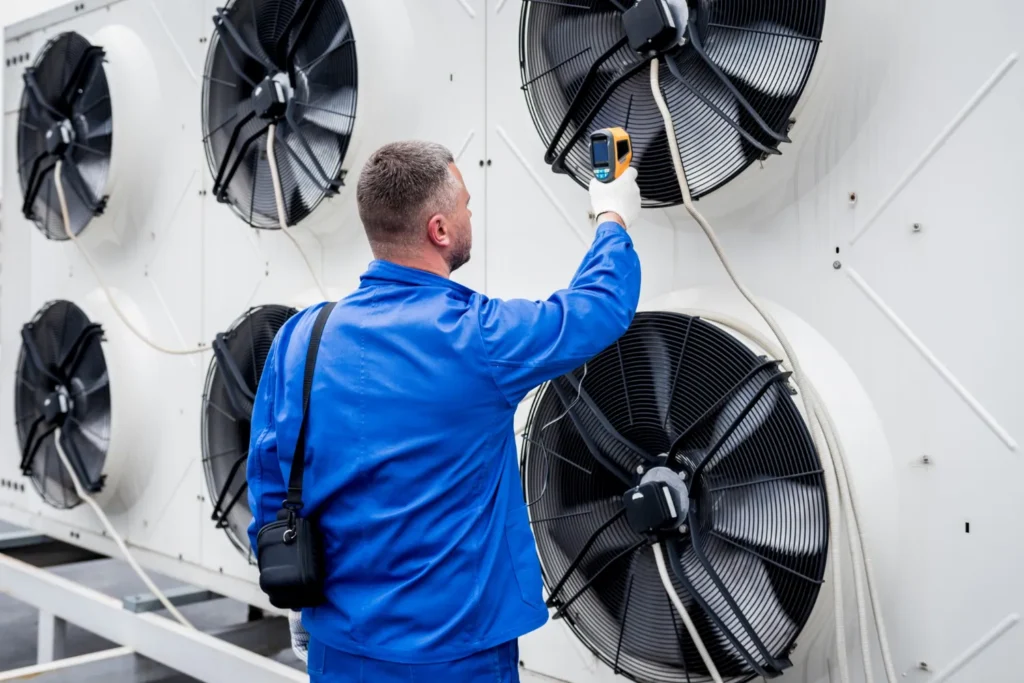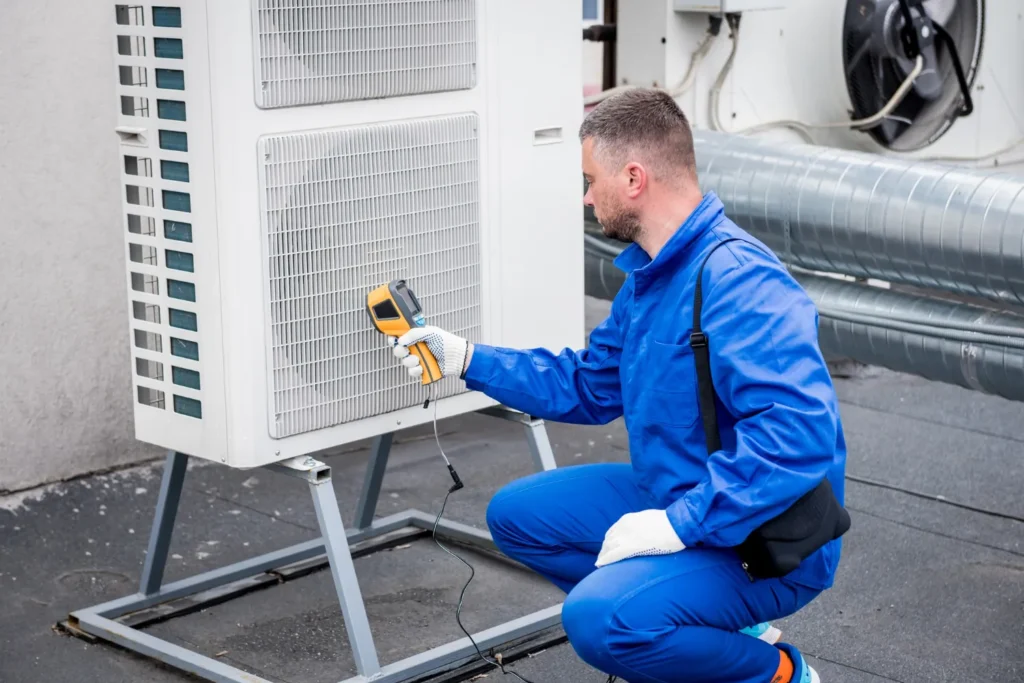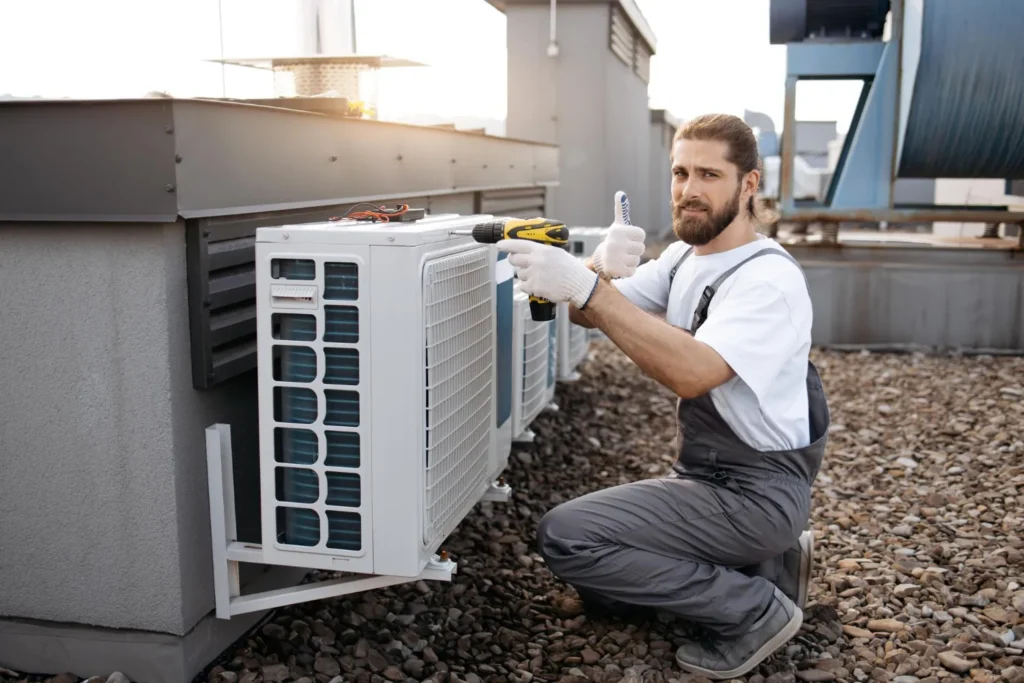Ductless Mini-Split AC Systems in Houston are transforming the way residents cool their homes, offering unmatched efficiency and flexibility. If you’re tired of dealing with the limitations of traditional central air systems or window units, a ductless mini-split could be your perfect solution. These systems provide targeted cooling without extensive ductwork, making them ideal for older homes, room additions, or spaces where installing ducts isn’t feasible.
In this guide, we’ll dive into why ductless mini-split systems are gaining popularity in Houston, how they work, and what benefits they offer over conventional cooling methods. From energy saver to enhanced comfort control, there’s a lot to love about these innovative systems. Ready to discover if a ductless mini split system is right for you? Keep reading to find out all the details and make an informed decision for your home cooling needs.
Table of Contents
What is a Ductless Mini-Split AC System?

A ductless mini-split AC system is a wall-mounted heating and cooling unit that doesn’t require extensive ductwork in traditional centralized systems. It’s a highly flexible and efficient solution for controlling the temperature in individual rooms or spaces within a home or business. Here’s a closer look at the key features and components of a ductless mini-split AC system:
- Outdoor Unit: The system’s heart houses the compressor, condenser coil, and fan. It is typically installed on the exterior of the building and expels heat from the indoor space.
- Indoor Units: These are installed in the rooms or areas that require temperature control. Each unit has an air handler that distributes the conditioned air into its designated space. Indoor units are connected to the outdoor unit via small conduits that house the power cable, refrigerant tubing, and a condensate drain line.
- Refrigerant Lines: These lines carry the refrigerant necessary to heat and cool the air between the outdoor and indoor units.
- Conduit: A conduit houses the power lines, refrigerant tubing, and condensate drain. It connects the outdoor and indoor units and requires only a small hole in the wall for installation, minimizing disruption and maintaining the building’s aesthetic appeal.
Types of Ductless Mini-split air conditioner
Ductless mini-split systems are available in various configurations, each tailored to meet different residential or commercial needs. Below is a detailed comparison of the primary types of ductless mini splits:
- Single Zone Systems:
- Purpose: Ideal for individual rooms or specific additions such as sunrooms, garages, or home offices.
- Configuration: Consists of one outdoor unit connected to one indoor unit.
- Advantages: It is perfect for spaces where installing ductwork is impractical or unnecessary. It provides independent control of the temperature in the designated area.
- Use Case: This method is best for homeowners who need to condition a space isolated from the central HVAC system or in newly added sections of a home.
- Multi-Zone Systems:
- Purpose: Suitable for larger homes or commercial properties with diverse cooling and heating demands across multiple rooms or areas.
- Configuration: Involves one outdoor unit linked to multiple indoor units.
- Advantages: Enables individual temperature control in different zones or rooms. Significantly increases energy efficiency by heating or cooling only occupied spaces, reducing energy waste compared to central HVAC systems.
- Use Case: This is ideal for properties with varying room usages, such as houses with upstairs bedrooms that are unused during the day or commercial spaces with varying occupancy levels.
Both configurations often feature:
- High SEER Ratings: Indicate superior energy efficiency in cooling mode.
- High HSPF Ratings: Reflect enhanced heating efficiency.
- Energy Star Certification: Assures additional energy savings and environmental benefits.
These systems provide a versatile solution for managing indoor climates without the complexities and inefficiencies of ducted HVAC systems.
Ductless Mini-Split AC Systems vs. Window AC Units
When deciding between ductless mini-split AC systems and window AC units, their efficiency, installation, and aesthetic impact must be considered.
Efficiency and Cost
While window AC units might seem less expensive, ductless mini-splits are significantly more energy-efficient in the long run. Mini-splits often have higher SEER ratings than window units, translating to lower energy costs over time. Additionally, window ACs can lead to energy loss due to poor insulation around the installation area. This problem is minimized with properly installed mini-splits.
Aesthetic and Security
From an aesthetic viewpoint, mini-splits offer a sleek, modern look that integrates smoothly with your home’s interior, unlike window units that can be bulky and obstructive. They also offer a security benefit since they do not require an open window, which can pose a security risk, particularly in ground-floor rooms.
Noise and Quality of Life
Mini-splits are celebrated for their quiet operation, contrasting with the often noisy window units. This makes mini-splits ideal for bedrooms, home offices, and other living spaces where a calm environment is essential.
Choosing the Right Ductless Mini-Split Air Conditioner
When selecting a ductless mini-split system, consider the following factors:
- Size and Capacity: Choose a unit with the appropriate BTU rating for the square footage of the area you wish to cool or heat. Oversized or undersized units can lead to inefficiencies and increased wear.
- Energy Ratings: Look for systems with high SEER and HSPF ratings to ensure maximum energy efficiency.
- Features: Consider models with remote control access, programmable timers, and air purifying filters for enhanced convenience and air quality.
What Size Mini-Split AC Do I Need?
Choosing the right size for your ductless mini-split system is crucial to ensure efficiency and comfort. Here’s a simple guide to help you select the appropriate size based on the square footage of your room:
Sizing Chart for Mini-Split Systems
| Room Size (Square Feet) | Mini-Split Capacity (BTU/hr) |
|---|---|
| Up to 150 sq ft | 5,000 BTU |
| 150 – 250 sq ft | 6,000 BTU |
| 250 – 350 sq ft | 8,000 BTU |
| 350 – 450 sq ft | 12,000 BTU |
| 450 – 550 sq ft | 14,000 BTU |
| 550 – 700 sq ft | 18,000 BTU |
| 700 – 1,000 sq ft | 24,000 BTU |
| 1,000 – 1,200 sq ft | 30,000 BTU |
| 1,200 – 1,400 sq ft | 34,000 BTU |
| 1,400+ sq ft | 36,000 BTU and up |
This chart provides a general guideline. However, other factors, such as ceiling height, window size, insulation quality, and even the number of occupants, can influence the required capacity. For precise sizing, consulting with a professional HVAC contractor is recommended.
Installation Requirements: Ductless Mini-Split AC Systems Vs Traditional HVAC Systems
There’s a notable difference in the installation needs between ductless mini-split AC systems and traditional HVAC systems. Below is a detailed comparison based on the available data:
Ductless Mini-Split AC Systems:
- Installation Complexity: Initially, the setup might seem complex due to the need for dedicated wall space for each indoor unit.
- Number of Units: Each room requiring temperature control needs its own “head,” which can elevate cost and complexity.
- Efficiency: Mini-splits are typically more efficient and cost-effective over time, offering substantial long-term savings.
- Maintenance: They demand specialized skills for upkeep and may be more challenging to service, yet they excel in energy efficiency and zoning flexibility.
Traditional HVAC Systems:
- Ductwork: These systems require extensive ductwork, posing a significant challenge, especially in homes lacking pre-existing ducts.
- Cooling and Heating: Versatile in nature, they handle cooling and heating efficiently across various seasons.
- Aesthetics: Often considered more aesthetically pleasing, traditional systems feature discreet vents rather than conspicuous wall units.
- Maintenance: These systems are generally easier to maintain, with more technicians readily available and possibly at a lower cost.
Professional Installation Vs DIY
While some homeowners may consider installing a ductless mini-split system as a DIY project, it is generally recommended to hire a professional. The precision required in handling refrigerant and ensuring proper installation often necessitates technical expertise and specialized tools.
Cost Analysis of Ductless Mini-Split Systems

Investing in a ductless mini-split system can be initially higher than other cooling options. However, the long-term savings and benefits often outweigh the upfront costs.
Initial Costs
- Purchase Price: Generally, a single-zone ductless mini-split system can cost between $1,500 and $2,000, and multi-zone systems can range from $2,500 to $7,500, depending on the capacity and features.
- Installation Costs: Professional installation can range from $300 to $800 per unit, varying by location in Houston and the complexity of the setup.
Long-term Savings
- Energy Savings: Due to their high energy efficiency, ductless mini-splits can significantly reduce monthly energy bills, especially in a climate like Houston, where air conditioner is used extensively.
- Maintenance Costs: Lower maintenance requirements and costs compared to central air systems contribute to additional savings over the unit’s lifespan.
Maintaining Your Ductless Mini-Split System
Regular Maintenance is crucial to keeping your ductless mini-split system running efficiently and extending its lifespan.
Basic Maintenance Tips
- Cleaning Filters: The filters inside the indoor units should be cleaned every month, especially during high usage periods. Most filters are reusable and can be cleaned with mild soap and water.
- Inspecting the Outdoor Unit: Ensure that the outdoor unit is free of debris, leaves, and dirt, which can obstruct airflow and reduce efficiency.
- Annual Check-ups: Have a professional technician perform a yearly maintenance check to inspect electrical connections, test system controls and ensure adequate refrigerant.
Troubleshooting Common Issues with Ductless Mini-Split Systems
Even the most reliable systems encounter issues, and ductless mini-splits are no exception. Here are some common problems and their potential solutions:
System Not Cooling or Heating Effectively
- Potential Causes: include dirty air filters, low refrigerant levels, issues with the thermostat, or blocked air delivery.
- Solutions: Clean or replace air filters, check for refrigerant leaks and recharge if necessary, ensure the thermostat is set correctly, and clear any obstructions around the indoor and outdoor units.
Unusual Noise
- Potential Causes: Loose components, debris in the system, or a malfunctioning fan or compressor.
- Solutions: Tighten any loose components, clean out debris, and if the noise persists, consult a professional technician to check the fan or compressor.
Ice Build-Up on Refrigerant Lines
- Potential Causes: Low refrigerant levels, poor circulation, or malfunctioning defrost cycle.
- Solutions: Check for refrigerant leaks, recharge the system, ensure proper airflow, and have a technician inspect the defrost system.
The system Turns Off Unexpectedly.
- Potential Causes: Overheating, electrical issues, or faulty sensors.
- Solutions: Ensure the system isn’t overloaded, check electrical connections for faults, and replace defective sensors.
By being aware of these common issues and knowing how to respond, homeowners can prevent minor problems from becoming significant disruptions.
Seasonal Adjustments for Maximizing Efficiency

Making seasonal adjustments is key to ensuring your ductless mini-split system operates optimally throughout the year in Houston’s varying climate.
Summer Settings
- Temperature Setting: Set your ductless air conditioner system to a comfortable yet energy-efficient temperature. 78°F is recommended when at home.
- Humidity Control: During Houston’s humid months, use the system’s dehumidifying function to maintain comfort without lowering the temperature further.
Winter Settings
- Temperature Setting: Keep the temperature at around 68°F when the home is occupied. Lower it slightly when away or asleep to save energy.
- Use of Heat Pump: Ensure the system switches to heating mode effectively and that the heat pump functions properly for those chilly days.
Adjusting settings according to the season not only enhances comfort but also reduces unnecessary energy use, leading to lower utility bills.
The Future of Ductless Mini-Split Technology
As we look to the future, the innovation in ductless mini-split technology continues to evolve, driven by consumer demand for more sustainable, efficient, and more intelligent home climate solutions.
Advancements in Technology
- Increased Efficiency: Future models are expected to have even higher SEER and HSPF ratings, making them more energy-efficient.
- Integration with Smart Home Systems: More systems will feature innovative technology, allowing for remote control, automated adjustments, and integration with other smart home devices.
Environmental Impact
- Reduced Carbon Footprint: By shifting towards more sustainable refrigerants and energy-efficient operation, ductless mini-splits contribute significantly to reducing a home’s carbon footprint.
- Recyclability and Sustainability: Manufacturers are focusing on making systems more recyclable and using materials that are less harmful to the environment.
Optimizing the Performance of Your Ductless Mini-Split System
Maximize the efficiency and lifespan of your ductless mini-split system by following proper installation practices and regular maintenance routines.
Long-Term Efficiency Strategies
- Routine Inspections: Regular professional inspections can identify and mitigate issues before they become serious, ensuring the system remains efficient.
- Upgrade Insulation: Improving the insulation of your home, particularly around windows and doors, can reduce the workload on your ductless system, thereby increasing its efficiency and longevity.
User-Friendly Tips
- Thermostat Settings: Utilize programmable or smart thermostats to create temperature schedules that align with your daily routine, reducing energy use when cooling or heating is unnecessary.
- Optimal Placement of Indoor Units: Ensure that the placement of indoor units allows for unobstructed airflow; avoid placing furniture or curtains in a way that blocks the unit.
Adaptability of Ductless Mini-Split AC Systems in Houston’s Climate
Ductless mini-split AC systems are well-suited to Houston’s hot and humid climate, providing adequate cooling and heating solutions year-round.
Thriving in Heat and Humidity
Houston’s climate is characterized by hot summers with high humidity, which can challenge many air conditioning system. Ductless mini-splits are particularly well-suited for this environment due to their efficient cooling mechanisms and humidity control capabilities. Heat pumps in these systems keep cooling efficient even on the hottest days, and their dehumidifying functions help maintain comfort without overcooling the room.
Seasonal Flexibility
Another advantage of mini-splits is their dual-function mini-split heat pumps, which provide cooling and heating. This makes them perfect for Houston’s mild winters, eliminating the need for a separate heating system. Their quick response times and precise temperature control allow for a comfortable indoor environment year-round, adjusting quickly as the seasons change in Texas.
Key Advantages and Drawbacks of Ductless Mini-Split Systems

Ductless mini-split systems offer numerous benefits for homeowners, especially in Houston’s climate. Here’s a concise summary of their advantages and drawbacks:
- Energy Efficiency: Mini-split systems can cut energy use by up to 30% compared to traditional central air systems that typically experience duct losses. Many homeowners in Houston have noted substantial reductions in their electricity bills, including one case where a user reported a 60% decrease.
- Noise Reduction: Outdoor units of mini-split systems tend to be quieter compared to traditional central air conditioning systems
- Customized Comfort: Multi-zone temperature control allows independent adjustments for different rooms, catering to varied needs across the home.
- Minimal Aesthetic Impact: Compact units blend seamlessly with most interiors, avoiding the bulkiness of window units or large vents.
- Simple Installation: Requires no ductwork, just a tiny hole connecting indoor and outdoor units, minimizing costs and home disruption.
- Low Maintenance: Easier and less costly than traditional HVAC systems. Routine Maintenance includes cleaning filters, checking refrigerant levels, and keeping the outdoor unit debris-free.
- Flexibility: Mini-splits offer adaptable temperature controls, making them ideal for homes with varying room temperatures and levels of sun exposure.
- Dealing with Humidity: Mini-splits are especially effective in Houston, where managing high humidity levels is a critical concern.
Practical Applications in Houston
- Single Rooms and Home Additions: These are ideal for areas like sunrooms, providing efficient cooling/heating without extending ductwork.
- Retrofitting Older Homes: This option is suitable for homes without existing ductwork. It offers modern heating and cooling with minimal structural changes.
Drawbacks
- Initial Cost: Higher upfront costs than window units or traditional HVAC systems.
- Aesthetic Concerns: Visible indoor units may appeal to only some homeowners.
- Regular Maintenance requires ongoing attention, mainly when cleaning filters and checking refrigerant levels.
Conclusion – Ductless Mini-Split AC Systems in Houston
Ductless mini-split systems are an excellent choice for enhancing home comfort sustainably and efficiently, particularly in Houston’s varying climate. These systems offer significant benefits in energy efficiency, cost savings, and environmental impact reduction. Technological advancements promise even greater integration with smart home devices, making them increasingly user-friendly.
Homeowners who stay informed about these innovations can ensure that their heating and cooling solutions are comfortable and environmentally conscious. Ductless mini-split ac systems present a compelling option for new builds, upgrades, or those seeking to lower their environmental footprint.
In summary, ductless mini-splits blend performance, sustainability, and future-readiness, making them ideal for today’s eco-aware homeowners. Whether building, upgrading, or aiming for sustainability, ductless mini-splits deliver efficiency and style.
FAQs About Ductless Mini-Split AC Systems in Houston
What is the lifespan of a ductless mini-split AC system?
The lifespan of a ductless mini-split AC system typically ranges from 15 to 20 years, depending on Maintenance and usage. Regular Maintenance can help ensure the system reaches the upper end of its lifespan.
What are the best brands of ductless mini-split AC systems for Houston?
Mitsubishi Electric, Daikin, Fujitsu, and LG are some of the best brands for ductless mini-split AC systems in Houston. These brands are known for their reliability, energy efficiency, and advanced technology.
How do ductless mini-split AC systems compare to traditional HVAC systems regarding energy efficiency?
Ductless mini-split systems are generally more energy-efficient than traditional HVAC systems due to their inverter technology and lack of ductwork, eliminating energy losses. They offer higher SEER ratings, leading to lower energy consumption and reduced electricity bills.
Are any rebates or incentives available for installing ductless mini-split AC systems in Houston?
Local utility companies and government programs often offer rebates and incentives for installing energy-efficient ductless mini-split systems. These incentives can offset the initial installation costs and encourage the adoption of sustainable ductless hvac system.
What are the factors to consider when choosing between ductless mini-split AC and traditional HVAC systems?
Key factors to consider include initial installation costs, energy efficiency, maintenance requirements, aesthetic preferences, and your home’s specific cooling and heating needs. Evaluating these factors will help you determine the most suitable system for your situation.
